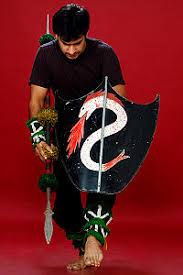 Thang -ta and Sarit - Sarak are traditional martial art types of the Indian state of manipur. The art is considered as an unconventional form of martial art as it is simply faultless in its evasive and offensive action in compared to many others. History says that Lainingthou Pakhangba, the dragon god - king, predestined King Mungyamba, to kill the fiend Moydana of Khagi with a spear and sword. The story then goes that God made the spear and sword during creating the world. The origin of Thang - ta and Sarit - Sarak goes as far back as the 17th century.Thang-Ta is most popular Meetei Martial arts in Manipur.The literal translation of Thang-ta in the Manipuri language is swords and spears. Interestingly, the mesmerizing dances of Manipuri have also been derived from these martial arts forms.Martial arts were banned during the British occupation of the region, but the 1950s saw a resurgence of the traditional fighting forms. Today thang-ta is the most popular of Meetei martial arts, practiced by both men and women. It is most often seen through demonstrations in cultural programs.
Thang -ta and Sarit - Sarak are traditional martial art types of the Indian state of manipur. The art is considered as an unconventional form of martial art as it is simply faultless in its evasive and offensive action in compared to many others. History says that Lainingthou Pakhangba, the dragon god - king, predestined King Mungyamba, to kill the fiend Moydana of Khagi with a spear and sword. The story then goes that God made the spear and sword during creating the world. The origin of Thang - ta and Sarit - Sarak goes as far back as the 17th century.Thang-Ta is most popular Meetei Martial arts in Manipur.The literal translation of Thang-ta in the Manipuri language is swords and spears. Interestingly, the mesmerizing dances of Manipuri have also been derived from these martial arts forms.Martial arts were banned during the British occupation of the region, but the 1950s saw a resurgence of the traditional fighting forms. Today thang-ta is the most popular of Meetei martial arts, practiced by both men and women. It is most often seen through demonstrations in cultural programs.
 In the Manipuri language, thang means sword and ta means spear. As its name implies, the sword and spear are the primary weapons in thang-ta. The spear can be used in its non-missile form while in close or thrown from afar. Other weapons used include the shield and axe. The earliest record of thang-ta and its sibling Sarit Sarak dates back from the early 1600s. It was taught for self-defence a few generations back but today it is relatively unknown outside Manipur. .Warriors would arrange to fight one-on-one as a way of settling feuds or disputes. The day before a duel, fighters might eat dinner together. Thang - ta is the use of sword against one or many challengers. Sarit - Sarak is the procedure of taking on armed or unarmed competitors. Manipuri kings made use of martial arts forms to take on the British. Because of Manipur's cultural similarity, geographic proximity and ethnic ties with Myanmar, thang-ta is closely related to banshay (Banshay is a weapon-based martial art of Burma.). Both can be practiced in three different ways: ritual, demonstration and combat.Thang - ta can be played in three ways. The first is in sync with the tantric practices, in the second there are sword and spear dances and the third way is the real fighting technique.
In the Manipuri language, thang means sword and ta means spear. As its name implies, the sword and spear are the primary weapons in thang-ta. The spear can be used in its non-missile form while in close or thrown from afar. Other weapons used include the shield and axe. The earliest record of thang-ta and its sibling Sarit Sarak dates back from the early 1600s. It was taught for self-defence a few generations back but today it is relatively unknown outside Manipur. .Warriors would arrange to fight one-on-one as a way of settling feuds or disputes. The day before a duel, fighters might eat dinner together. Thang - ta is the use of sword against one or many challengers. Sarit - Sarak is the procedure of taking on armed or unarmed competitors. Manipuri kings made use of martial arts forms to take on the British. Because of Manipur's cultural similarity, geographic proximity and ethnic ties with Myanmar, thang-ta is closely related to banshay (Banshay is a weapon-based martial art of Burma.). Both can be practiced in three different ways: ritual, demonstration and combat.Thang - ta can be played in three ways. The first is in sync with the tantric practices, in the second there are sword and spear dances and the third way is the real fighting technique.

 These are the Manipuri Martial Arts, the traditions of which had been passed down over the centuries. It is a very energetic and skillful art and is a way to hone one's battlecraft during the peace time in the olden days when every Manipuri was a warrior who is required to serve his country at the time of war. Long and precise practices is required and only the brave and athletic could excel. The art as seen today observe elaborate rituals and rules which are strictly observed by the participants.
These are the Manipuri Martial Arts, the traditions of which had been passed down over the centuries. It is a very energetic and skillful art and is a way to hone one's battlecraft during the peace time in the olden days when every Manipuri was a warrior who is required to serve his country at the time of war. Long and precise practices is required and only the brave and athletic could excel. The art as seen today observe elaborate rituals and rules which are strictly observed by the participants.
